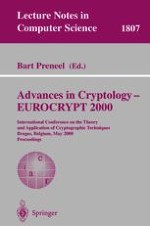2000 | Buch
Advances in Cryptology — EUROCRYPT 2000
International Conference on the Theory and Application of Cryptographic Techniques Bruges, Belgium, May 14–18, 2000 Proceedings
herausgegeben von: Bart Preneel
Verlag: Springer Berlin Heidelberg
Buchreihe : Lecture Notes in Computer Science
Enthalten in: Professional Book Archive
